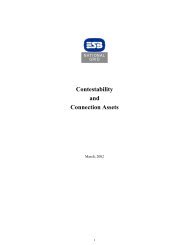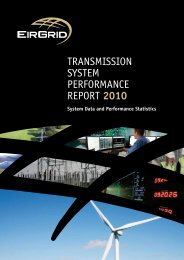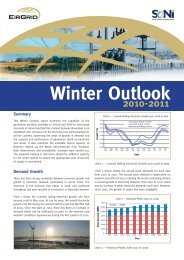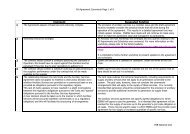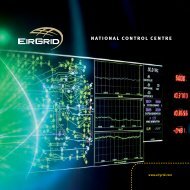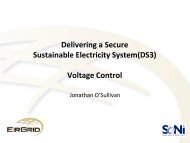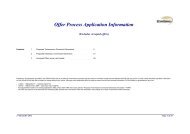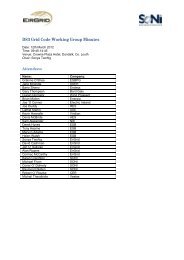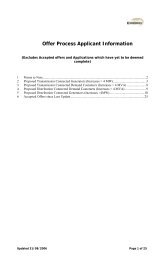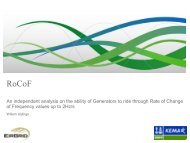Defining ROCOF - Eirgrid
Defining ROCOF - Eirgrid
Defining ROCOF - Eirgrid
Create successful ePaper yourself
Turn your PDF publications into a flip-book with our unique Google optimized e-Paper software.
<strong>Defining</strong> <strong>ROCOF</strong><br />
Background / Proposed Modification<br />
to Irish Grid Code
Background<br />
• <strong>ROCOF</strong> is not currently defined in the Irish Grid<br />
Code and is not mentioned in NI Grid Code<br />
• Need to specify how <strong>ROCOF</strong> is calculated<br />
– Definition will affect ultimate <strong>ROCOF</strong> capability sought<br />
from generators<br />
• EirGrid bringing renewed proposals to Ireland<br />
GCRP on <strong>ROCOF</strong><br />
– A proposal had previously been discussed at GCRP<br />
• SONI will also discuss <strong>ROCOF</strong> proposals at NI<br />
GCRP
<strong>ROCOF</strong> during a 3-Phase Fault
Example 2
Proposed Modification - Background<br />
• Generators should not trip for very high<br />
<strong>ROCOF</strong> values seen during transient faults<br />
– Fault ride through clauses must apply here<br />
– There has never been a problem historically<br />
• <strong>ROCOF</strong> value / Calculation Window should be<br />
chosen such that electrical transient effects<br />
are excluded<br />
– But should be high enough to capture loss of<br />
largest infeed / system separation type events
Proposal 1<br />
Rate of Change of Frequency (<strong>ROCOF</strong>):<br />
The rate of increase or decrease of Frequency as measured at the User’s Connection Point averaged<br />
over the time period as set out in CC.7.3.1.1(d).<br />
PROPOSED CHANGE TO CC7.3.1.1(d)<br />
CC.7.3.1.1 Each Generation Unit, shall, as a minimum, have the following capabilities:<br />
•remain synchronised to the Transmission System during rate of change of Transmission System<br />
Frequency of values up to and including 0.5 Hz per second for a Rate of Change of Frequency of up to<br />
X Hz per second averaged over Y milliseconds. Voltage dips may cause localised <strong>ROCOF</strong> values in<br />
excess of X Hz per second for short periods, and in these cases, the Fault-Ride Through clause<br />
CC.7.3.1.1(h) supercedes this clause;<br />
NOTE:<br />
X in the range 1-2Hz/sec<br />
Y in the range 150-500ms
Proposal 2<br />
Rate of Change of Frequency (<strong>ROCOF</strong>):<br />
The rate of increase or decrease of Frequency as measured at the User’s Connection Point over a<br />
time period greater than the time for the synchronous Generators on the system to reach Coherency<br />
but no greater than 500ms in any case.<br />
Coherency:<br />
A group of synchronous Generators are defined as coherent after an Event if the relative<br />
displacement between their power angles is constant.<br />
PROPOSED CHANGE TO CC.7.3.1.1(d)<br />
CC.7.3.1.1<br />
remain synchronised to the Transmission System during rate of change of Transmission System<br />
Frequency of values up to and including 0.5 Hz per second remain synchronised to the<br />
Transmission System for a Rate of Change of Frequency of up to X Hz per second. Voltage dips<br />
resulting in loss of coherency may cause localised <strong>ROCOF</strong>s in excess of this value for short periods,<br />
and in these cases, the Fault-Ride Through clause CC.7.3.1.1(h) supercedes this clause;<br />
NOTE:<br />
X in the range 1-2Hz/sec<br />
Y in the range 150-500ms



